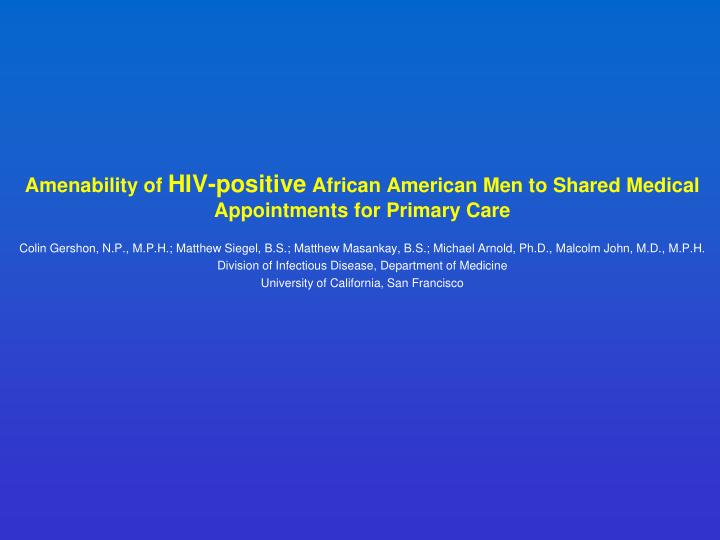



Amenability of HIV-positive African American Men to Shared Medical Appointments for Primary Care Colin Gershon, N.P., M.P.H.; Matthew Siegel, B.S.; Matthew Masankay, B.S.; Michael Arnold, Ph.D., Malcolm John, M.D., M.P.H. Division of Infectious Disease, Department of Medicine University of California, San Francisco
Disparities in HIV positive men of color • HIV positive men of color: • Constitute a disproportionate % of individuals living with HIV • Experience poorer health outcomes after HIV diagnosis • This disparity is due to a variety of factors including: • Low adherence to anti-retroviral therapy • Mistrust of the medical system • Higher rates of missed clinic visits • Provider bias
How a Shared Medical Appointment (SMA) Model can address HIV health disparities • The shared medical appointment (SMA) is a model in which medical care is provided to two or more patients concurrently followed by short, private sessions of history- taking and physical examination. • Evidence suggests SMAs may improve: • Patient trust in the medical system • Medical appointment attendance • Patient satisfaction with medical care • Biological outcomes • Cost of care • Provider satisfaction • Within HIV+ African American population, SMA is expected to: • Improve clinic visit attendance • Improve patient satisfaction with care • Improve patient health literacy through increased interactions with provider and other specialists • Build support around health issues which may help address isolation, HIV stigma and health care fatigue • Develop skill-set to deal with issues common to patient group…and more
SMA Amenability Study Parameters • Study Aims: • percentage of HIV+ AA men at 360 amenable to SMA participation (groups of 4 patients) • socioeconomic, demographic ,or other factors potentially associated with willingness to participate in an SMA • programmatic design factors potentially associated with willingness to participate in an SMA • Hypotheses: • majority of participants would be amenable to SMA participation at 360 • no significant association between willingness to participate and socioeconomic or demographic factors • association between programmatic factors and willingness to participate
Demographics Table 1. Demographics
Amenability to Participate in SMA Figure 1. How strongly do you agree with the following statement: “I would consider participating in [an SMA at this clinic]” No demographic , socioeconomic , or care variables were associated with willingness to participate at α = 0.05, except for patient satisfaction with their medical care. A positive trend was seen between this variable and amenability with P=.04.
Programmatic Factors Associated with Willingness to Participate Table 2. Among those willing to participate, what programmatic factors are most desirable?
Conclusions • Over 2/3 of participants were amenable to a SMA • No demographic or socioeconomic variables were associated with willingness to participate • Significant trend between patient satisfaction with current care and willingness to participate • Programmatic factors more associated with willingness to participate included: • confidentiality • private time with provider • group led by primary provider • familiarity with other patients • length of appointment • The SMA model may be a feasible clinical intervention at 360, and at other HIV clinics in urban environments. • Next Steps – 6 month pilot with Mallory Johnson at Center for AIDS Prevention Studies
Recommend
More recommend